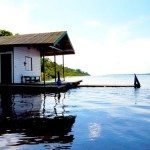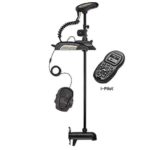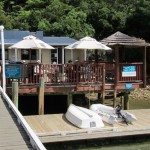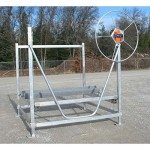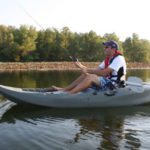I came across a question from a new boater asking if they needed an anchor. The answer is “yes, you absolutely do.” It’s required by law in many places and it can be one of the first pieces of emergency equipment you’ll need. Whether you sail up a river, or cross oceans, an anchor is an essential gear item.
When choosing which anchor is best for you, the important factors to consider are reliability to set, holding power, veering and damage, storing. The questions you need to ask yourself are:
- Which bottom surface will I need the anchor to work in?
- What size boat am I operating?
- Am I fishing or going to have to ride out a storm?
This article will give you a guide to the various types of anchor, old and new. Which types of anchor work in which bottom surface, is important. Newer anchor technology appears to be working well and from the anchor tests we’ve looked at, the new designs outperform the tradition types.
Disclosure: This article may contain affiliate links. If you make a purchase after clicking on a link I may earn a small commission at no extra cost to you.
Anchors for pontoon boats
Pontoon boats frequently require 2 anchors and 2 windlasses or winches. Because of their high profile, pontoon boats tend to swing in the breeze more than other boats.
When swimming, fishing or just relaxing on the lake or river with family and friends, 2 anchors will keep the boat where you want it. They also prevent the pontoon boat from drifting away from swimmers and into other boats or shorelines – that’s peace of mind.
Modern anchor design using the latest engineering technology have made anchors not only better, but also lighter in weight. In tests conducted by the U.S. Navy, it was determined that the best holding anchors were among some of the lightest. Anchor design rather than weight has greater affect on holding power.
In the past steel was commonly used in boat anchors which dramatically increased the weight. Many materials are now stronger than steel. Aluminum-magnesium alloy is frequently used in anchors, and is stronger and much lighter than steel. Always set two anchors if you expect a wind or current change.
Boat Anchors and Anchoring
Anatomy of an Anchor
To get an idea of how each anchor type works we must know each of its parts and functions. The shank is the stem of the anchor in which direction is pulled to set (bury) the anchor. The crown connects the various parts of the modern anchor. The stock turns the anchor into an attitude that enables the flukes to dig into the sea bed. The optional tripping ring is used for tripping with a separate line, allowing the anchor to break out. The flukes will be buried into the seabed. The very tip of a fluke is sometimes called the bill.
Traditional Types of Anchor
There are 6 main types of anchor. They are the Fisherman, the Claw or Bruce, the Plow or Plough, the Fluke, the Grapnel and Mushroom. Each of these designs have many anchors that relate to the basic design principle. For example the Plow type named because it acts like a farmers plow, has the CQR and Delta which belong to this anchor family.
Fisherman Anchor
A traditional design often seen on the bows of old Sailing Ships like HMS Victory. The design is a non-burying type of marine anchor, and grabs rocks with one arm penetrating the seabed. It’s reputation for use in rock, kelp, and grass is good. However holding power to weight ratio is among the worst of all types of anchor.
The main weakness in design is the ability to foul the cable over changing tides. One of the Fisherman’s arms can catch the anchor Rhode, or cable, and accidentally trip the anchor. It’s difficult to handle and bring aboard without scarring the topsides and doesn’t stow well in an anchor roller.
What sea bottom does the Fisherman anchor suit?
It’s best suited for rocks, and kelp bottoms, but not good holding in sand or mud. The Fisherman has arms which lodges themselves in a rock bed, or in grass and kelp the arms allow the anchor to penetrate through the kelp.
Modern examples of this style of anchorss are: Luke Storm Anchor, kedge and Navy.
Bruce/Claw Anchor
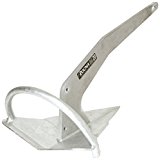
The Bruce anchor was designed by Peter Bruce back in the 1970s. The Bruce also known as the Claw. Claw-types set quickly in most sea beds and although not an articulated design, they have the reputation of not breaking out with pull direction, instead slowly turning in the bottom to align with the force. They offer a fairly low holding power to weight ratio and generally have to be over-sized to compete with other types. On the other hand they perform relatively well with low rode scopes and set fairly reliably. The traditional Claw anchor has rounded flukes. The Claw Anchor showed poor performance in the many anchor tests, which are attributed to the anchor failing to dig in, due to the rounded flukes. The Rocna Spade and Supreme anchors faired much better in many anchor tests. The Rocna Spade and Supreme anchors and are among a new breed of anchor with roll bars and/or pointed tips.
Claw anchors are best suited for sand and muddy bottoms where the design can dig in. Claw types boat anchors have difficulty penetrating weedy bottoms and grass, tending to float over weed and kelp rather than digging in.
Modern examples of claw type anchors include; Bruce, Claw, Rocna, Spade, and Supreme
Plow or Plough Anchor
The Plow’s holding power over a wide variety of bottom types, makes it a top choice of cruising boaters, named for its similarity to the farmers plow.
When dropped in the water, a plow often lands on its side. However when pulled by the ground tackle, the Plow buries itself. The shape allows it to reset fairly easily if the wind or tide shift the boat position.
A number of manufacturers produce a plough-style design, with all being based on, or they are direct copies of, the original CQR the Coastal Quick Release.
With a hinged shank, the QCR design allows the anchor to turn with direction changes rather than breaking out. It’s also arranged to force the point of the plough into the bottom if the anchor lands on its side.
The more recent Delta uses an unhinged shank and a plough with specific angles to develop slightly superior performance.
The plough is heavier than average for the amount of resistance developed, because of the use of lead or other dedicated tip-weight. This may take a slightly longer pull to set thoroughly.
What sea bottom does the Plow anchor suit?
A good choice for bottom surface types like sand, mud, and kelp grass.
Modern examples of Plow type anchors include; Delta, CQR Plow or Plough
Fluke Anchor
The fluke style anchor, named due to its large flukes, uses a stock at the crown to which 2 large flat surfaces are attached. The stock is hinged so the flukes can orient toward the bottom (on some designs the flukes angle can be optimized depending on the bottom type.)
The design is a burying style and once well set develops an amazing amount of resistance. The light-weight and compact flat design makes it easy to retrieve and it’s relatively easy to store. Some anchor rollers and hawse pipes can accommodate a fluke-style anchor.
High-performance designs are available, such as the Fortress, which are lighter in weight for a given area and in tests have shown better than average results. Once set, the fluke anchor tends to break out and reset when the direction of force changes dramatically, such as with the changing tide. On some occasions it might not reset but instead drag.
What sea bottom does the Fluke anchor suit?
It’s recommended for sand and muddy bottom surfaces. But it has difficulty penetrating kelp and weed-covered bottoms, as well as rocky and particularly hard sand or clay bottoms. If there’s a lot of current or the boat is moving while dropping the anchor it may float over the bottom due to the large fluke area acting as a wing.
Examples of Fluke Anchor types; Fortress Danforth and Guardian
Click here to find a range of pontoon boat anchors at best prices on Amazon
Grapnel
The grapnel style is simple to design and build. The design is a non-burying style, with one or more tines digging in and the remainder above the seabed. In coral it is often able to set quickly by hooking into the structure. A grapnel is often quite light, and used aboard smaller boats where its weight makes it relatively easy to bring aboard. The Grapnel is sometimes difficult to retrieve.
Grapnels rarely have enough fluke area to develop much hold in sand, clay, or mud. It’s not unknown for the anchor to foul on its own rode, like the fisherman, or to foul the tines with refuse from the bottom, preventing it from digging in. It is quite possible for this anchor to find such a good hook that, without a trip line, it is impossible to retrieve.
Mushroom Anchors
Mushroom anchors work best in soft muddy bottoms, where they can create suction which can be difficult to break. Recommended for small boats to use as a lunch hook, but not practical for larger boats.
Download our free guide to anchoring to find out how to anchor any boat in any conditions.
Thanks to Mike Hobson for this informative article. You can find more from Mike at http://myboatsgear.com/newsletter/200788.asp where Mike is the editor. Article Source: http://EzineArticles.com/?expert=Mike_Hobson

